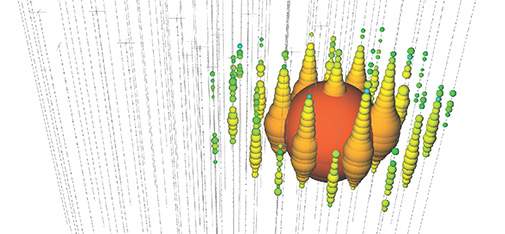IceCube sees first signs of high-energy extraterrestrial neutrinos
The IceCube Neutrino Observatory, of which Denmark is a recent member have discovered 28 very high-energy neutrinos that comes from outside our solar system.

Visualisation of the highest energy neutrino event recored in IceCube. The strings are located within the icecap at the south pole and records light emitted from neutrinos colliding with protons in the ice. Image: IceCube Collaboration
The IceCube Neutrino Observatory, a particle detector buried in the Antarctic ice, is a demonstration of the power of the human passion for discovery, where scientific ingenuity meets technological innovation. Today, nearly 25 years after the pioneering idea of detecting neutrinos in ice, the IceCube Collaboration announces the observation of 28 very high-energy particle events that constitute the first solid evidence for astrophysical neutrinos from cosmic accelerators. Details of the research are published in Science 342 (2013) 1242856.
“The observation of such energetic neutrinos is a union between the exotic nature of our universe and the intellectual conquest of mankind”, says D. Jason Koskinen, Assistant Professor at the Niels Bohr Institute and IceCube collaborator. “ We expect more events in the upcoming years, and so this result may mark the beginning of neutrino astronomy.”
The 28 high-energy neutrinos have energies greater than 50,000,000,000,000 electron volts, which exceeds the vast majority of the more conventional neutrinos which originate either in the sun or in the Earth’s atmosphere. Because they rarely interact with matter, the nearly massless subatomic particles called neutrinos can carry information about the workings of the highest-energy and most distant phenomena in the universe.
"We expect more events in the upcoming years, and so this result may mark the beginning of neutrino astronomy.
D. Jason Koskinen,
Assistant Professor
Neutrinos from the outer reaches of our galaxy, or beyond, have long been theorized to provide insights into the powerful cosmic objects that may be the origins of high-energy cosmic rays: supernovas, black holes, pulsars, active galactic nuclei and other extreme extragalactic phenomena.
IceCube is comprised of 5,160 digital optical modules suspended along 86 strings embedded in a cubic kilometer of ice beneath the South Pole. The National Science Foundation-supported observatory detects neutrinos through the tiny flashes of blue light, called Cherenkov light, produced when neutrinos interact in the ice.
The IceCube detector was completed in December 2010 after seven years of construction. It was built on time and on budget and in its first two years has performed above its design specifications.
“The success of IceCube builds on the efforts of hundreds of people around the world,” says Botner. “IceCube collaborators made it all happen—from the design and the deployment in a harsh environment, proving the feasibility of the concept, to data harvesting and physics analysis. All required concerted efforts that ultimately have led to the observations presented in this paper.”
D. Jason Koskinen is the institutional lead for NBI on IceCube and along with Niels Bohr Professor Subir Sarkar (Oxford & NBI) and NBI visiting scientist Jenni Adams (U. of Cantebury), who are also IceCube collaborators, represent a new direction in Danish physics.
The IceCube Neutrino Observatory was built with funding from the National Science Foundation, USA, with assistance from partner funding agencies around the world. The University of Wisconsin–Madison is the lead institution, and the international collaboration includes 250 physicists and engineers from the USA, Germany, Sweden, Belgium, Switzerland, Japan, Canada, New Zealand, Australia, UK and Korea. On October 10, 2013, the Niels Bohr Institute became a full member of the IceCube collaboration, making it the first Danish institution in IceCube.
